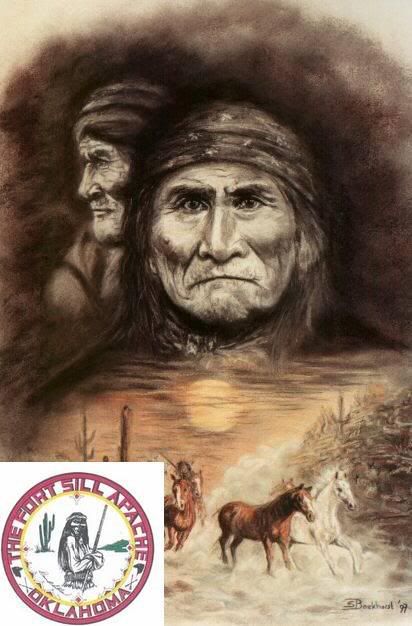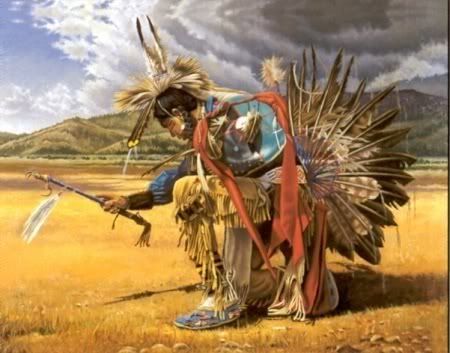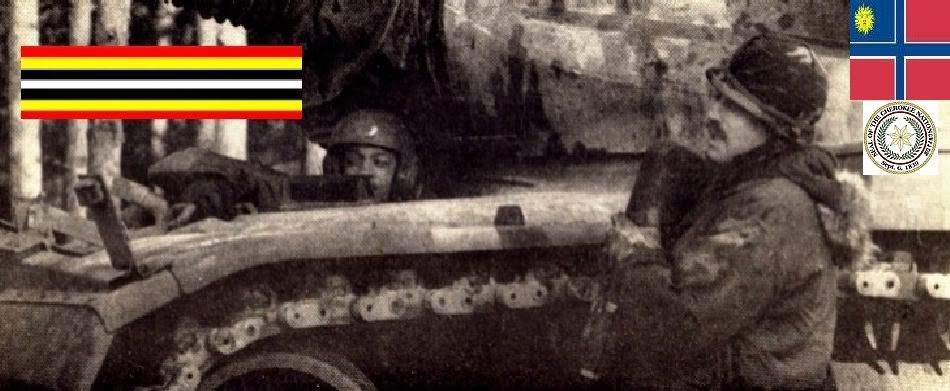|

Geronimo
(1829-1909)
Warriors Citation
Geronimo {jur-ahn'-i-moh}, or Goyathlay ("one who yawns"), was born in what is today western New Mexico, but was then still
Mexican territory. He was a Bedonkohe Apache (grandson of Mahko) by birth and a Net'na during his youth and early manhood.
His wife, Juh, Geronimo's cousin Ishton, and Asa Daklugie were members of the Nednhi band of the Chiricahua Apache. He was
reportedly given the name Geronimo by Mexican soldiers, although few agree as to why. As leader of the Apaches at Arispe in
Sonora, he performed such daring feats that the Mexicans singled him out with the sobriquet Geronimo (Spanish for "Jerome").
Some attributed his numerous raiding successes to powers conferred by supernatural beings, including a reputed invulnerability
to bullets. Geronimo's war career was linked with that of his brother-in-law, Juh, a Chiricahua chief. Although he was not
a hereditary leader, Geronimo appeared so to outsiders because he often acted as spokesman for Juh, who had a speech impediment.
Geronimo was the leader of the last American Indian fighting force formally to capitulate to the United States. Because he
fought against such daunting odds and held out the longest, he became the most famous Apache of all. To the pioneers and settlers
of Arizona and New Mexico, he was a bloody-handed murderer and this image endured until the second half of this century. To
the Apaches, Geronimo embodied the very essence of the Apache values, agressiveness, courage in the face of difficulty. These
qualities inspired fear in the settlers of Arizona and New Mexico. The Chiricahuas were mostly migratory following the seasons,
hunting and farming. When food was scarce, it was the custom to raid neighboring tribes. Raids and vengeance were an honorable
way of life among the tribes of this region. By the time American settlers began arriving in the area, the Spanish had become
entrenched in the area. They were always looking for Indian slaves and Christian converts. One of the most pivotal moments
in Geronimo's life was in 1858 when he returned home from a trading excursion into Mexico. He found his wife, his mother and
his three young children murdered by Spanish troops from Mexico. This reportedly caused him to have such a hatred of the whites
that he vowed to kill as many as he could. From that day on he took every opportunity he could to terrorize Mexican settlements
and soon after this incident he received his power, which came to him in visions. Geronimo was never a chief, but a medicine
man, a seer and a spiritual and intellectual leader both in and out of battle. The Apache chiefs depended on his wisdom.

When the Chiricahua were forcibly removed (1876) to arid land at San Carlos, in eastern Arizona, Geronimo fled with a band
of followers into Mexico. He was soon arrested and returned to the new reservation. For the remainder of the 1870s, he and
Juh led a quiet life on the reservation, but with the slaying of an Apache prophet in 1881, they returned to full-time activities
from a secret camp in the Sierra Madre Mountains. In 1875 all Apaches west of the Rio Grande were ordered to the San Carlos
Reservation. Geronimo escaped from the reservation three times and although he surrendered, he always managed to avoid capture.
In 1876, the U.S. Army tried to move the Chiricahuas onto a reservation, but Geronimo fled to Mexico eluding the troops for
over a decade. Sensationalized press reports exaggerated Geronimo's activities, making him the most feared and infamous Apache.
The last few months of the campaign required over 5,000 soldiers, one-quarter of the entire Army, and 500 scouts, and perhaps
up to 3,000 Mexican soldiers to track down Geronimo and his band. In May 1882, Apache scouts working for the U.S. army surprised
Geronimo in his mountain sanctuary, and he agreed to return with his people to the reservation. After a year of farming, the
sudden arrest and imprisonment of the Apache warrior Ka-ya-ten-nae, together with rumors of impending trials and hangings,
prompted Geronimo to flee on May 17, 1885, with 35 warriors and 109 women, children and youths. In January 1886, Apache scouts
penetrated Juh's seemingly impregnable hideout. This action induced Geronimo to surrender (Mar. 25, 1886) to Gen. George CROOK.
Geronimo later fled but finally surrendered to Gen. Nelson MILES on Sept. 4, 1886. The government breached its agreement and
transported Geronimo and nearly 450 Apache men, women, and children to Florida for confinement in Forts Marion and Pickens.
In 1894 they were removed to Fort Sill in Oklahoma. Geronimo became a rancher, appeared (1904) at the Louisiana Purchase Exposition
in St. Louis, sold Geronimo souvenirs, and rode in President Theodore Roosevelt's 1905 inaugural parade. Geronimo's final
surrender in 1886 was the last significant Indian guerrilla action in the United States. At the end, his group consisted of
only 16 warriors, 12 women, and 6 children. Upon their surrender, Geronimo and over 300 of his fellow Chiricahuas were shipped
to Fort Marion, Florida. One year later many of them were relocated to the Mt. Vernon barracks in Alabama, where about one
quarter died from tuberculosis and other diseases. Geronimo died a prisoner of war, unable to return to his homeland. He was
buried in the Apache cemetery at Fort Sill, Oklahoma. From: historical accounts & records


LINK TO BRAVEHORSE WARRIORS VOLUME TWO
|

